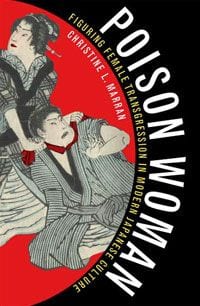
For Japanophiles, one of the pleasures of that most peculiar country is observing the way that inexplicable fads, obsessions, and enthusiasms periodically seize the populace. One such obsession, outlined by Christine L. Marran in her academic study Poison Woman: Figuring Female Transgression in Modern Japanese Culture, was with a small group of real-life female murderers whose exploits were conveyed in newspaper serials, popular novels, memoirs, kabuki performances, and more, beginning in the second half of the 19th century and coinciding with the rise of modern Japan.
The most infamous of these women, Takahashi Oden, became notorious precisely because her every action upset the natural order. A “hellion” as a young girl, she beat up on boys and, when she grew up, became a highly aggressive and sexualized woman who “was said to have poisoned her leprosy-ridden husband to be free of having to care for him” and also fatally stabbed an acquaintance. She eventually was beheaded for her crimes.
The popularity of these tales, all out of proportion to the actual prevalence of murder committed by women, is a reflection, Marran contends, of a belief “that sexuality and aggressiveness in woman leads to the corruption of the self and the state, thereby demonizing female sexuality and scapegoating female autonomy as unfeminine.” The stories, as one of the scholars that Marran cites points out, “became the place for expressing doubts about rapid westernization and modernization,” and used hyperbole and elision to marginalize women and influence them to behave in a “proper” way.
Given that even contemporary Japan is highly sexist — probably more so than any other modern, Western-oriented culture — it is hardly surprising that, back in 1879, the authorities were so fixated on Takahashi Oden’s sexuality and its supposed influence on her criminal behavior that, after her death, her “reproductive organs were preserved in formaldehyde … and passed from research collection to research collection,” in each case resulting in the inevitable determination that “her genitals and reproductive organs were … pathologically large.”
The obsessive focus on crimes and criminals that are in actuality quite rare but that represent some unspoken psychic terror or unresolved social conflict isn’t limited only to Japan, of course. In our own country, the utterly unfounded hysteria about “satanic child abuse” was, some have conjectured, a reflection of our collective guilt and fear about putting our children in day care in order to allow women to join the full-time workforce. The current 24-hour news channel obsession with “missing white women” also reflects certain unspoken societal fears, just as, in their own way, do various “junk science” panics about Alar on our apples, radiation from power lines, and brain tumors supposedly caused by cell phones.
Given Marran’s explication of the manner in which Poison Woman narratives were artificial constructs driven primarily by social pressures, it is a bit disappointing that Marran herself occasionally succumbs to the social pressures of her own milieu, which is to say academia. She is an academic; fair enough. And this is clearly an academic study, so one doesn’t come to it expecting a visceral, pop-culture account of the poisonings, murders and sexual escapades of the Poison Women, who, after all, aren’t even the subject of her book: Her subject is how the private acts of these women were politicized and mythologized.
Still, it sometimes appears almost as if Marran feels obliged to write mouthful-of-mashed-potato sentences in order to curry the approval very worst writers we have, the French-influenced literary critics and philosophers. For example, at one point Marran writes (brace yourself):
My concern, however, is not to consider books of nature within a retrospective diachronic history of sexology within a nativist / Western dichotomy but rather to explore the way in which discussions of the body in books of nature dovetail with those in poison woman fiction and suggest that in both we see a physiocentric discourse that identifies every type of body as an integral part of the natural order through an appeal to positivist thought. It is precisely this logic that enabled a physiological explication of transgressive behavior and an elision of the political underpinnings of that transgression.
The “precisely” in the second of these two lumpy sentences is almost poignant in its evident faith that readers will see precision where there is none. And, as far as her constant use of the word “transgression” and its several variants, one can almost say that Marran (like, it would appear, many other academics) has a pathological obsession with it, as in this fairly typical sentence: “The traveling woman who transgresses previously bounded regional boundaries is depicted as transgressing social boundaries.”
Transgressions aside, there are other redundancies in that sentence — previously bounded boundaries? — as there is in this overlapping passage, as well: “The pretense of an aestheticized self-proclaimed abjection was not a discursive option for the female confessor. This aesthetic stance of abject social outcast is not available to her for several reasons …”
But when Marran isn’t waving around words like “liminal”, and “transgressive” and “hegemony” the way a wild-eyed preacher wields “Jesus” and “the Devil,” she is a clear-eyed, knowledgeable, and sympathetic guide to a little-known corner of Japanese culture. What’s more, her feminist thesis is highly plausible and, in most passages, capably rendered. (She switches out of the mashed-potato mode often enough to make this book pretty absorbing, especially when she recounts the crimes themselves, the manner in which they were politicized, and the evolution of the Japanese popular press.)
One wishes, only, that she herself had been willing to transgress just a little bit against the hegemony of contemporary academic convention and write a serious study of her subject that was also a consistent, rather than intermittent, pleasure to read.

![Call for Papers: All Things Reconsidered [MUSIC] May-August 2024](https://www.popmatters.com/wp-content/uploads/2024/04/all-things-reconsidered-call-music-may-2024-720x380.jpg)



